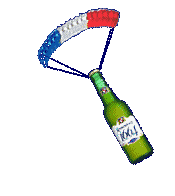

[lah-guhr] Beer that is stored in its cask or vat until free of sediment and crystal clear. It is a light, bubbly, golden brew.
Well, try as I have, there really isn't much to be said about normal English lager, either by me or on the web. There is, of course, considerably more regarding good European lagers, such as those from Belgium and the Czech Republic, which are detailed further down the page. Personally, I'm not overly fussed about most lagers. A few cold ones in the summer is okay, but as I was saying only today in the pub, I would never pick it over a good pint of real ale. Still, for the uninitiated amongst you, I shall gather together bits and bobs, including links, reviews and the like, and post them here. Come back soon...
Worth checking out is Shea and Darren's Beer Critique which, although a little misguided on the English beers (in my opinion) does contain loads of reviews on a wide variety of bottled lagers from around the world.
Most English lagersare a poor comparison to those traditionally brewed on the continent. Here, then, is some background, examples and links to the better class of lager.
For an absolutely massive list of world lagers (including their ABV strengths - very important) and other lager related stuff, check out the Lads Lager Page.
If you do insist on drinking lager, then the Shandy Society of Great Britain and Arnside will admit you as an associate member. Serves you right, too....
The most common beer type is Pilsner. This is a broad category, with many regional variations resulting in a rich variety of tastes. A good Pilsner is quite malty, and often particularly hoppy. However, there are few other fermentation by products such as yeastiness. Fermentation is slow, and performed under fairly cool conditions. This results in a characteristic smoothness of texture, a clear golden colour.
